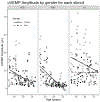Age Effects of Bone Conduction Vibration Vestibular-evoked Myogenic Potentials (VEMPs) Using B81 and Impulse Hammer Stimuli
- PMID: 33735908
- PMCID: PMC8387331
- DOI: 10.1097/AUD.0000000000001024
Age Effects of Bone Conduction Vibration Vestibular-evoked Myogenic Potentials (VEMPs) Using B81 and Impulse Hammer Stimuli
Abstract
Objective: Recently developed, the Radioear B81 bone oscillator allows for higher bone conduction vibration output; however, normative data are lacking regarding its use in vestibular-evoked myogenic potential (VEMP) testing. The purpose of this study was to examine the effect of age on cervical and ocular VEMP (c- and oVEMP) responses using the B81 and to compare with air conduction stimuli (ACS) and impulse hammer (IH) VEMP response characteristics.
Design: c- and oVEMP were completed with ACS, B81, and IH stimuli in healthy participants (age range = 10 to 87 years, n = 85).
Results: Regardless of stimulus type, c- and oVEMP amplitudes and response rates decreased with age. For cVEMP response rates, ACS performed better or equal to B81, which was superior to the IH. For cVEMP corrected amplitude, ACS had significantly higher amplitudes compared with B81 and IH. There was no difference in cVEMP corrected amplitude between B81 and IH. For oVEMP, response rates were comparable between stimuli with the largest disparity in response rates occurring in the oldest groups where IH outperformed both ACS and B81. For oVEMP amplitude, IH had significantly higher amplitudes compared with B81 and ACS. There was no difference in oVEMP amplitude between B81 and ACS.
Conclusions: Age significantly affected c- and oVEMP amplitudes regardless of stimulus type (ACS, B81, IH). All stimuli are appropriate for eliciting c- and oVEMP in the young individuals. While ACS resulted in higher cVEMP corrected amplitudes, either ACS or B81 are appropriate for older individuals. However, for oVEMPs, higher response rates and larger amplitudes were noted for IH followed by B81 and ACS. Overall, the B81 performed well across the lifespan for c- and oVEMPs and may be a reasonable bone conduction vibration option for patients with absent ACS VEMPs, but at this time is not recommended as a replacement to ACS.
Copyright © 2021 Wolters Kluwer Health, Inc. All rights reserved.
Figures









References
-
- Akin FW & Murnane OD. (2001). Vestibular evoked myogenic potentials: Preliminary report. J Am Acad Audiol, 12, 445. - PubMed
-
- Bath AP, Harris N, McEwan, & Yardley MP. (1999). Effect of conductive hearing loss on the vestibulo-collic reflex. Clin Otolaryngol, 24:181–183. - PubMed
-
- Cheng PW, Chen CC, Wang SJ, Young YH. (2009). Acoustic, mechanical and galvanic stimulation modes elicit ocular vestibular-evoked myogenic potentials. Clin Neurophysiol, 120:1841–1844. - PubMed
-
- Chou CH, Hsu WC, Young YH. (2012). Ocular vestibular-evoked myogenic potentials via bone-conducted vibration in children. Clin Neurophysiol, 123: 1880–1885. - PubMed
-
- Clinard CG, Piker EG, Thorne AP, Surface EN, Anderson AE, Beacham VA, Crouse MC, Whitney VH, Depaolis RA. (2019). Maximum output and low-frequency limitations of B71 and B81 clinical bone vibrators: Implications for vestibular evoked myogenic potentials. Ear Hear, epub ahead of print. - PubMed
Publication types
MeSH terms
Grants and funding
LinkOut - more resources
Full Text Sources
Other Literature Sources

